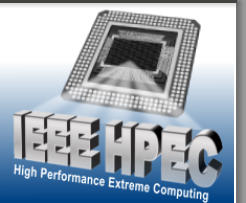
2018 IEEE High Performance
Extreme Computing Conference
(HPEC ‘18)
Twenty-second Annual HPEC Conference
25 - 27 September 2018
Westin Hotel, Waltham, MA USA


Comprehensive EDA Tools Addressing the Intersection of Classical and Quantum Computing
The technical challenges and the high economic cost associated with scaling CMOS beyond 5nm heated the debate about what
technology will lead the post-CMOS era. Will Josephson Junction (JJ) based superconducting electronics (SCE) operated at
cryogenic temperatures be the natural candidate? Is SCE embarking on its own Moore’s law, promising to reach a level of VLSI
realization? How about Quantum Computing (QC) -- Can QC play a leading role in advancing the computational needs currently
fulfilled by the most powerful supercomputers? Is QC capable of efficiently executing algorithms handled by classical computers?
At the same time this debate was taking place, the news from the QC front has been very encouraging. Chips with 49, 50, and 72
qubits have been implemented. The talk of “quantum supremacy” is creating heated discussion and excitement. New technologies
for QC with longer de-coherence times and improved error rates are equally encouraging. However, a reality is emerging that an
efficient QC system is one that encompasses tight interaction with CMOS based classical computers and memory stacks. Cold
CMOS will likely have a significant role to play. New high speed, high throughput, and energy-efficient communication links will be
required to handle the interactions. Optical communications links has a role to play there. Our expectation of further advancement
in this area will require the design community to leverage mature, robust, and tightly integrated Engineering Design Automation
(EDA) software tools for the realization of every component of such a system, be it CMOS, JJ based SCE or QC, as well as the
integrated SoC and System architecture and environment. We at Synopsys have maintained leadership in EDA tools for CMOS
with a set of tools that encompass the whole flow, from device and process simulation (TCAD) through full system verification.
Synopsys EDA tools are stand-alone modules that are designed to interact seamlessly with each other and with industry
standards, culminating in the best point tools to enable a comprehensive flow for system realization. It is through this
modularization that some tools in the CMOS flow can be immediately leveraged with some enhancement to be utilized for such a
comprehensive flow. Others must be created. It is also no secret that we at Synopsys are involved in a 5-year Superconducting
Electronics (SCE) project funded by IARPA to develop add-ons to our EDA tools and to develop a full flow for SCE circuit design.
This enhancement effort touches practically all our EDA tools from TCAD through device Spice modeling, simulation, extraction,
verification, library development, place and route, timing, and verification. As we progress in executing this project, we see many
parallels to the kinds of challenges that we and the EDA and CMOS industry faced 30 years ago especially in Analog and Mixed
Signal designs. For a future consideration of QC and links of QC to Classical computing, we will look for as much reuse as
possible, but we may find the need to create and insert completely new tools as well. In this talk I will cover our CMOS EDA tools
and flow, I will relate our experience in developing EDA tools for SCE and cold CMOS as well as our EDA efforts in integrating
CMOS and photonics. I will discuss what we see as the challenges faced by the EDA and the design community in realizing an
automated eco system that integrates QC, cold CMOS, CMOS and photonics.
A Parallel Implementation of FANO using OpenMP and MPI
We present a parallel implementation of the Fast Accurate NURBS Optimization (FANO) program using OpenMP and MPI. The
software is used for designing imaging freeform optical systems comprised of NURBS surfaces. An important step in the design
process is the optimization of the shape and position of the optical surfaces within the optical system. FANO uses the Levenberg-
Marquardt (LM) algorithm for minimization of the merit function. The parallelization of the code is achieved without modifying
readily available commercial or open source implementations of the LM algorithm. Instead, MPI instructions are being used to
distribute the computation of the Jacobian over multiple nodes, each of which performs the computationally intensive task of
raytracing. The results from the raytracing are collected on the master and used for calculating the values of the variable
parameters for the next iteration. Speed increases of ~100x and more are possible when running on the cluster of the MIT Lincoln
Laboratory Super Computing Center (LLSC).
Towards Energy-Proportional Anomaly Detection in the Smart Grid
Phasor Measurement Unit (PMU) deployment is increasing throughout national power grids in an effort to improve operator
situational awareness of rapid oscillations and other fluctuations that could indicate a future disruption of service. However, the
quantity of data produced by PMU deployment makes real-time analysis extremely challenging, causing grid designers to invest in
large centralized analysis systems that consume significant amounts of energy. In this paper, we argue for a more energy-
proportional approach to anomaly detection, and advocate for a decentralized, heterogeneous architecture to keep computational
load at acceptable levels for lower-energy chipsets. Our results demonstrate how anomalies can be detected at real-time speeds
using single board computers for on-line analysis, and in minutes when running off-line historical analysis using a multicore server
running Apache Spark.
Soft-Core, Multiple-Lane, FPGA-based ADCs for a Liquid Helium Environment
Collecting analog signals and system control are fundamental tasks in many applications as are found in automotive,
communication, and sensor network domains. In many of those applications, latency is critical and FPGA-based systems an
attractive alternative. Traditionally, external ADC (analog to digital converter) chips are used for analog to digital signal conversion
and transfer of the digital signals to FPGA. In large-scale quantum system experiments, the implementation of this classic control
infrastructure is a challenge. In particular, the FPGA-based control system must work in a liquid helium environment. Also, to
improve the system's reliability, we need to integrate multiple lanes of soft core ADC into the FPGA. In this paper, we propose a
method of building high-speed ADCs with time to digital converters (TDCs). The experimental results show that the ADC can
achieve a sampling rate of 100Msa/s with a 6 bits resolution for signals ranging from 0 to 3 V. In our design the ADC uses primarily
the ISERDES logic of Xilinx FPGA plus a small amount of CLBs. Thus our design can integrate 24 lanes of soft-core ADCs into a
Xilinx XC7A100t-2csg324 FPGA.
Thursday, September 27. 2018
New Frontiers & Quantum Computing
10:20-12:00 in Eden Vale A1/A2



Comprehensive EDA Tools Addressing the Intersection of
Classical and Quantum Computing
The technical challenges and the high economic cost associated
with scaling CMOS beyond 5nm heated the debate about what
technology will lead the post-CMOS era. Will Josephson Junction
(JJ) based superconducting electronics (SCE) operated at
cryogenic temperatures be the natural candidate? Is SCE
embarking on its own Moore’s law, promising to reach a level of
VLSI realization? How about Quantum Computing (QC) -- Can QC
play a leading role in advancing the computational needs currently
fulfilled by the most powerful supercomputers? Is QC capable of
efficiently executing algorithms handled by classical computers? At
the same time this debate was taking place, the news from the QC
front has been very encouraging. Chips with 49, 50, and 72 qubits
have been implemented. The talk of “quantum supremacy” is
creating heated discussion and excitement. New technologies for
QC with longer de-coherence times and improved error rates are
equally encouraging. However, a reality is emerging that an
efficient QC system is one that encompasses tight interaction with
CMOS based classical computers and memory stacks. Cold
CMOS will likely have a significant role to play. New high speed,
high throughput, and energy-efficient communication links will be
required to handle the interactions. Optical communications links
has a role to play there. Our expectation of further advancement in
this area will require the design community to leverage mature,
robust, and tightly integrated Engineering Design Automation (EDA)
software tools for the realization of every component of such a
system, be it CMOS, JJ based SCE or QC, as well as the integrated
SoC and System architecture and environment. We at Synopsys
have maintained leadership in EDA tools for CMOS with a set of
tools that encompass the whole flow, from device and process
simulation (TCAD) through full system verification. Synopsys EDA
tools are stand-alone modules that are designed to interact
seamlessly with each other and with industry standards, culminating
in the best point tools to enable a comprehensive flow for system
realization. It is through this modularization that some tools in the
CMOS flow can be immediately leveraged with some enhancement
to be utilized for such a comprehensive flow. Others must be
created. It is also no secret that we at Synopsys are involved in a 5-
year Superconducting Electronics (SCE) project funded by IARPA to
develop add-ons to our EDA tools and to develop a full flow for SCE
circuit design. This enhancement effort touches practically all our
EDA tools from TCAD through device Spice modeling, simulation,
extraction, verification, library development, place and route, timing,
and verification. As we progress in executing this project, we see
many parallels to the kinds of challenges that we and the EDA and
CMOS industry faced 30 years ago especially in Analog and Mixed
Signal designs. For a future consideration of QC and links of QC to
Classical computing, we will look for as much reuse as possible, but
we may find the need to create and insert completely new tools as
well. In this talk I will cover our CMOS EDA tools and flow, I will
relate our experience in developing EDA tools for SCE and cold
CMOS as well as our EDA efforts in integrating CMOS and
photonics. I will discuss what we see as the challenges faced by
the EDA and the design community in realizing an automated eco
system that integrates QC, cold CMOS, CMOS and photonics.
A Parallel Implementation of FANO using OpenMP and MPI
We present a parallel implementation of the Fast Accurate NURBS
Optimization (FANO) program using OpenMP and MPI. The
software is used for designing imaging freeform optical systems
comprised of NURBS surfaces. An important step in the design
process is the optimization of the shape and position of the optical
surfaces within the optical system. FANO uses the Levenberg-
Marquardt (LM) algorithm for minimization of the merit function. The
parallelization of the code is achieved without modifying readily
available commercial or open source implementations of the LM
algorithm. Instead, MPI instructions are being used to distribute the
computation of the Jacobian over multiple nodes, each of which
performs the computationally intensive task of raytracing. The
results from the raytracing are collected on the master and used for
calculating the values of the variable parameters for the next
iteration. Speed increases of ~100x and more are possible when
running on the cluster of the MIT Lincoln Laboratory Super
Computing Center (LLSC).
Towards Energy-Proportional Anomaly Detection in the Smart
Grid
Phasor Measurement Unit (PMU) deployment is increasing
throughout national power grids in an effort to improve operator
situational awareness of rapid oscillations and other fluctuations that
could indicate a future disruption of service. However, the quantity
of data produced by PMU deployment makes real-time analysis
extremely challenging, causing grid designers to invest in large
centralized analysis systems that consume significant amounts of
energy. In this paper, we argue for a more energy-proportional
approach to anomaly detection, and advocate for a decentralized,
heterogeneous architecture to keep computational load at
acceptable levels for lower-energy chipsets. Our results
demonstrate how anomalies can be detected at real-time speeds
using single board computers for on-line analysis, and in minutes
when running off-line historical analysis using a multicore server
running Apache Spark.
Soft-Core, Multiple-Lane, FPGA-based ADCs for a Liquid
Helium Environment
Collecting analog signals and system control are fundamental tasks
in many applications as are found in automotive, communication,
and sensor network domains. In many of those applications,
latency is critical and FPGA-based systems an attractive alternative.
Traditionally, external ADC (analog to digital converter) chips are
used for analog to digital signal conversion and transfer of the digital
signals to FPGA. In large-scale quantum system experiments, the
implementation of this classic control infrastructure is a challenge. In
particular, the FPGA-based control system must work in a liquid
helium environment. Also, to improve the system's reliability, we
need to integrate multiple lanes of soft core ADC into the FPGA.
In this paper, we propose a method of building high-speed ADCs
with time to digital converters (TDCs). The experimental results
show that the ADC can achieve a sampling rate of 100Msa/s with a
6 bits resolution for signals ranging from 0 to 3 V. In our design the
ADC uses primarily the ISERDES logic of Xilinx FPGA plus a small
amount of CLBs. Thus our design can integrate 24 lanes of soft-
core ADCs into a Xilinx XC7A100t-2csg324 FPGA.
Thursday, September 27. 2018
New Frontiers & Quantum Computing
10:20-12:00 in Eden Vale A1/A2
HPEC 2018
25 - 27 September 2018
Westin Hotel, Waltham, MA USA





































